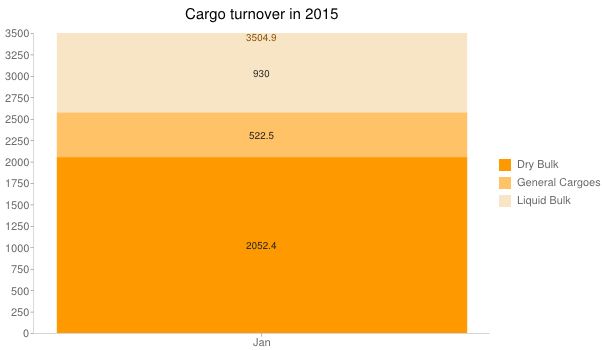Good for Business, Latvia, Port, Tourism, Transport
International Internet Magazine. Baltic States news & analytics
Wednesday, 24.04.2024, 10:53
In January, cargo turnover at Riga Port grew by 8.3%
 Print version
Print version
3872 vessels called the Freeport of Riga in 2014, including 3797 commercial vessels. Although the total number of vessels compared with the year 2013 slightly decreased (-1.4%), the total gross tonnage of vessels increased and reached 48.3 million GT (+ 2.3%). The most significant increase was registered in the average tanker GT indicator (+ 16%). If in previous years, a tanker with a gross tonnage of more than 40 000GT called the port only 2-3 times a year, 27 calls of such vessels were registered in 2014.
The average GT of dry bulk carriers, calling the port, also increased (+ 14%), which to some extent compensates a reduction in the number of vessels in the relevant vessel group. Similarly, the average GT of cruise ships visiting the port has increased (+ 5%). Container carrier lines, operating at the Freeport of Riga, used to employ vessels with larger GT (+ 10% to the average GT indicator) in 2014.
All this confirms the fact that the cargo owners continue to optimize transport costs and try to use larger vessels where possible. And it is evident that the port of Riga has to urgently implement fairway dredging project and build additional deep-water berths.

A major dry bulk cargo port
Due to constantly increasing volume of dry bulk cargo the port of Riga has become a major player in the dry bulk cargo segment, not only among the Baltic States’ ports, occupying a leading position, but in the entire Baltic region. The volume of cargo, handled during the first month of the current year, proves that Riga is strengthening its position in the dry bulk segment. 2.05 million tons were handled in January, which is by 19.3% more than in the beginning of 2014.
Traditionally, coal shipments constitute the greatest amount of cargo and provide dynamic growth. 1.3 million tons were handled in January, which is by 18.7% more than in the last year's reporting period. “To a large extent an increase in coal cargo can be attributed to Russia's political and economic situation. In its attempts to stabilize the country's financial flows Russia is increasingly producing and exporting different types of energy resources, including coal and oil products. Assuming that the stabilization of the Russian economy will take a long time and that the cargo owners have chosen to transship their cargo via the port of Riga, there is no reason to believe, that coal cargo volumes could shrink in the near future. Of course, there is always the possibility that various political decisions might lead to substantial changes in the maritime transport system. Our investments in the port infrastructure and the fairway dredging pay off – we see that cargo owners are increasingly choosing exactly the port of Riga,” explains Mr. Andris Ameriks, the Board Chairman of the Freeport of Riga Board.
The second most important group of cargo, which has increasingly bigger share in the total Riga port cargo structure, is mineral fertilizers. The new terminal capacity is being used more fully and this is confirmed by the fact that mineral fertilizers’ handling volume increased by 79.6%, compared to January of the last year, and reached nearly 254 thousand tons per month.
Unspecified cargo group also experienced a substantial growth (+ 43.5%), and the amount of handled cargo has reached 252 thousand tons. Transshipment of all cargo positions increased in the framework of the relevant group.
At the same there is a decline in grain products’ handling, there are by 60.2% less ore cargoes; volumes of such cargo as lumber, wood chips, different metals and ferro-alloy have decreased.
General cargo remains at the last year level
Despite 11.3% increase in container shipping, the average volume of cargo, handled in the framework of general segment in January this year, remains almost at the same level as at the beginning of the previous one – i.e.522 thousand tons. There is a slight increase (+ 1.6%) in timber shipping. The most significant decrease occurred in Roll on/ roll off cargo group (-51.8%). This is directly related to reduction of the Tallink ferry regular voyages. There is a certain decrease of various metals and food cargo volumes, but due to the fact that these types of cargo play insignificant role in the total structure of the port operation, there is no major impact on total port cargo volume.
Decrease in liquid bulk
There is a decrease by 6.3% in liquid bulk cargo volume this January compared with the last year's first month. In January 2015 930 thousand tons have been handled. It should be noted that in last January liquid cargo segment demonstrated very good results, exceeding the volume of January 2013 by 56.3%, and reaching 992 thousand tons, but later the average monthly amount has become stable and volume of the first month of this year is equivalent to the average liquid cargo amount of 2014.
Logically, the reduced number of scheduled flights resulted in a decrease in the number of passengers (-40.6%).








 «The Baltic Course» Is Sold and Stays in Business!
«The Baltic Course» Is Sold and Stays in Business!

